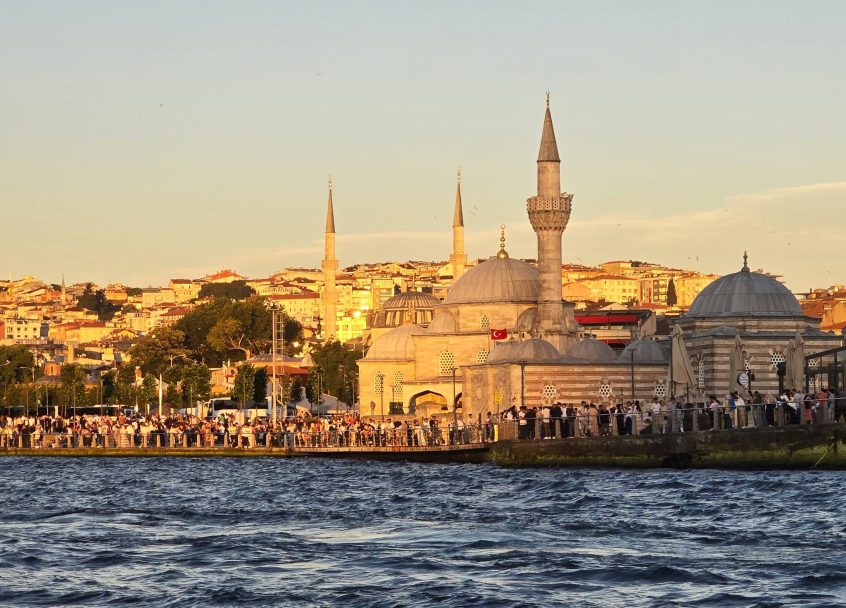Disembarkation from the ship was swift and easy, especially since I had a wheelchair assist. That was a good thing, since it was about half a mile from the gangway to the taxi stand (including clearing immigration and claiming luggage).
The taxi driver, Ali, introduced himself and then immediately started suggesting he could be my driver. He would take me anywhere I wanted to go for the day. Mind you, his English was spotty, my Turkish nonexistent, but Google translate did a fine job. After some back and forth we came to a price that seemed okay to each of us.
After checking in at the hotel (the Radisson President in Old Town), we were off. I had no idea where we were going. Ali first took me to Pierre Loti Park, a scenic overlook where we had Turkish coffee and enjoyed the view. Since I’d arrived at the taxi in a wheelchair, he took great pains to help me negotiate uneven surfaces and stairs. His courtly assistance was greatly appreciated.
While heading to the Blue Mosque we passed through an intriguing neighborhood, and I asked Ali to stop. He told me we were in Balat. I was taken by the colorful wooden buildings and fanciful decorations. I later read that Balat is considered one of the oldest and most spectacular districts of İstanbul. It is a neighborhood that has traditionally been home to minorities in the city, with many Jewish families and Greek Orthodox families making it their homes. If I have time I plan to go back and explore a bit more.
Then we were off to Taksim Square and the Blue Mosque. Fortunately, I arrived before the crush of tour groups (they were pouring in as I left). I’d been to the Blue Mosque before, it is a must-see sight in Istanbul. Also known as the Sultan Ahmed Mosque, it was built in the 1600s. It is famous for its stunning architecture, featuring six minarets (most mosques have four) and a cascade of domes. Its interior is decorated with over 20,000 handmade tiles in blue hues, giving the mosque its nickname.
When I visited the first time, we went to the second floor to see the tiles up close. This time it was not allowed. I was glad to revisit the magnificent structure, though I quickly tired of the crowds. What I did recall was the feeling of spaciousness and, apart from the tourists, a place where spirits can soar. It is like visiting the great European cathedrals.
Across from the Blue Mosque is the Hagia Sophia another architectural marvel and a symbol of the city’s rich history. Originally built as a cathedral by Emperor Justinian I in 537 AD, it was the world’s largest building and an engineering wonder of its time. Renowned for its massive dome and stunning mosaics, it later served as a mosque. I didn’t have the energy to fight the crowds, so Ali and I left the area.
When deciding what I wanted to do while in Istanbul I came across the Istanbul Modern Art Museum. Reading that there was an exhibition of the work of Olafur Eliasson, I knew I had to see it. He is one of my favorite contemporary artists. Titled, “Your Unexpected Encounter,” the exhibit reflects the artist’s interest in light, color, perception, movement, geometry, and environment. The show reaffirmed my love of his creativity.
Once in the museum I was taken by other exhibits, especially one entitled Timeless Curiosities. The show demonstrated how contemporary artists are using technology. It was a fascinating, and beautiful, show.
It was now mid-afternoon, time to return to the hotel and get into my room. I had a short rest, then had the hotel staff find a taxi for me (not as easy as it sounds) to take me to a dock on the Bosphorus where I would board a sunset cruise.
After the taxi dropped me off, I promptly got lost. Thank you to What’s App for allowing me to contact the tour guide and get detailed instructions.
The sunset cruise was wonderful. It was a small boat with perhaps twenty-five passengers. The crew constantly brought us Turkish treats and drinks. The guide gave an astounding amount of information (most of which I’ve already forgotten) about the history, architecture, and culture of Istanbul. I recalled from my previous visit here that the Bosphorus Strait, a large, moving body of water separates the European and Asian halves of Türkiye. But as the guide pointed out, that’s about geography not culture. Both Asian and European Istanbul are similar in every important way.
Along the two-hour tour we passed many dozens of mosques, several forts, gorgeous mansions, a zillion other tour boats, ferries, and freighters. But most of all, people—Istanbul is an EXCEPTIONALLY large city. With sixteen million people, it has double the population of New York City.
As the sun set everything glowed. The perfect ending to a wonderful day.

